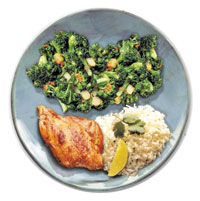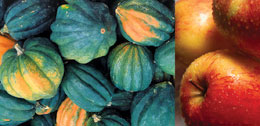 |
Vivien Morris, M.S., R.D., M.P.H., L.D.N.
Director of Community Initiatives
Nutrition and Fitness for Life Program
Department of Pediatrics
Boston Medical Center
|
African Americans have inherited a traditional diet comprised of many healthy foods rich in flavor. Returning to those traditions can play an important role in preventing and treating metabolic syndrome. Metabolic syndrome (also known as insulin resistance syndrome) is a cluster of health conditions — high blood glucose levels, excess weight around the waist, low HDL (good) cholesterol levels, high levels of triglycerides (another fat in the blood), and high blood pressure — that increase a person’s risk of diabetes and cardiovascular disease. Although technically not a component of metabolic syndrome, high LDL (bad) blood cholesterol levels are also a significant contributor to cardiovascular disease.
Individuals with metabolic syndrome may be advised by their doctors to lose weight, make lifestyle changes to improve their diets and increase their physical activity, and may also be prescribed medication to lower their cholesterol and blood pressure levels.
How to know if you need to lose weight
Reaching and maintaining a healthy weight are goals that help reduce the risk of developing metabolic syndrome. The body mass index is a measure of weight relative to height and is useful in determining whether a person is at a healthy weight. A body mass index of 19 to 24 is considered healthy, 25 to 29 is overweight and over 30 is obese. It is important to ask for a body mass index evaluation at each regular check up. To know whether your excess body weight is located in a body area that puts you at increased risk for metabolic syndrome, your doctor may take a measurement of your waist. Excess waist weight is a measurement of more than 40 inches for men and more than 35 inches for women.
Tips for a healthy diet from the American Diabetes Association
• Eat lots of vegetables and fruits and in a variety of colors. Be sure to include non-starchy vegetables like spinach, carrots, broccoli or green beans.
• Choose whole grain foods over processed grain products. Try brown rice or whole wheat spaghetti.
• Include dried beans (like kidney or pinto beans) and lentils in your meals.
• Include fish in your meals three times a week.
• Choose lean meats like cuts of beef and pork that end in “loin,” such as pork loin and sirloin. Remove the skin from chicken and turkey.
• Choose non-fat dairy products, such as skim milk, non-fat yogurt and non-fat cheese.
• Choose water and calorie-free “diet” drinks instead of regular soda, fruit punch, sweet tea and other sugar-sweetened beverages.
• Choose liquid oils for cooking instead of solid fats that can be high in saturated and trans fats and cholesterol. Remember that fats are high in calories, so watch your portion sizes of added fats.
• Cut back on high calorie snack foods and desserts like chips, cookies, cakes and full-fat ice cream.
• Watch your portion sizes. Eating too much of even healthy foods can lead to weight gain.
The plate method
 Here’s a simple way to ensure a healthy diet at meal times. Draw an imaginary line through the center of your pate. Divide one half of the plate into two quarters. About one fourth of your plate should be filled with grains or starchy foods such as brown rice, whole grain pasta, potatoes, corn or peas. Another fourth should be protein foods like meat, fish or poultry. Fill the remaining half of the plate with non-starchy vegetables like broccoli, green beans, carrots, collards, or salad. You may have a piece of fruit or a small serving of bread on the side. Then add a glass of water and a glass of non-fat milk. Here’s a simple way to ensure a healthy diet at meal times. Draw an imaginary line through the center of your pate. Divide one half of the plate into two quarters. About one fourth of your plate should be filled with grains or starchy foods such as brown rice, whole grain pasta, potatoes, corn or peas. Another fourth should be protein foods like meat, fish or poultry. Fill the remaining half of the plate with non-starchy vegetables like broccoli, green beans, carrots, collards, or salad. You may have a piece of fruit or a small serving of bread on the side. Then add a glass of water and a glass of non-fat milk.
How to increase vegetables in your diet
Historically, African Americans raised kitchen gardens and used these foods to supplement and stretch the family diet. Greens, peas, beans, tomatoes, corn, cucumbers, sweet potatoes, white potatoes, onions and many other vegetables were part of the typical diet for all ages. Today, few African Americans consume the recommended three to seven servings of vegetables per day. Vegetables are naturally high in vitamins and minerals, high in fiber and generally low in calories. With a little planning, you can increase your servings of vegetables. This will likely have the added benefit of helping you cut back on higher calorie food and snack items.
Try these four suggestions:
1. Hold the cheese but add extra vegetables (tomatoes, onions, green peppers, etc.) to your scrambled eggs, omelets or sandwiches;
2. Pack peeled baby carrots, cucumber sticks or green and red pepper slices for lunch and snacks;
3. Prepare two vegetables of different colors for dinner meals;
4. Try one new vegetable or a familiar vegetable prepared in a different way each week.
The recipe below is simple to prepare, low in calories and gives a different twist on baked squash.
Baked Acorn Squash with Apple Stuffing
 Number of Servings: 4 Number of Servings: 4
Serving Size: ½ squash
Acorn squash is the most common member of the winter squash family. Its bright-orange flesh bakes beautifully, coming out moist, rich and tender. Its pretty dark green and orange-streaked shell makes a perfect container for the delicious apple stuffing.
Ingredients
2 small acorn squash, halved and seeded
1 apple, peeled and diced
2 tbsp celery, diced
2 tbsp onion, finely chopped
2 tsp margarine, melted
Pinch salt
Pinch fresh ground black pepper
Instructions
Preheat the oven to 400 degrees F. Prepare square baking pan with nonstick pan spray. Place the squash cut side down in a baking pan. Bake for 20 minutes. While the squash is baking, combine the apples, celery, onion, margarine and 2 tablespoons water in a medium bowl; mix well. Turn the squash cut side up. Sprinkle with salt and pepper. Divide the apple mixture to fill the cavities of the squash. Bake the stuffed squash halves, covered with foil, for 30 minutes more. Serve hot.
Nutritional Information (per serving):
Calories 87. Calories from Fat 19. Total Fat 2 g. Saturated Fat 0 g. Cholesterol 0 mg. Sodium 63 mg. Carbohydrates 18. Dietary Fiber 5 g. Sugar 20 g. Protein 1 g. Dietary Exchange: 1 starch.
(Recipe from: The New Family Cookbook for People with Diabetes. Published by the American Diabetes Association.)
|
